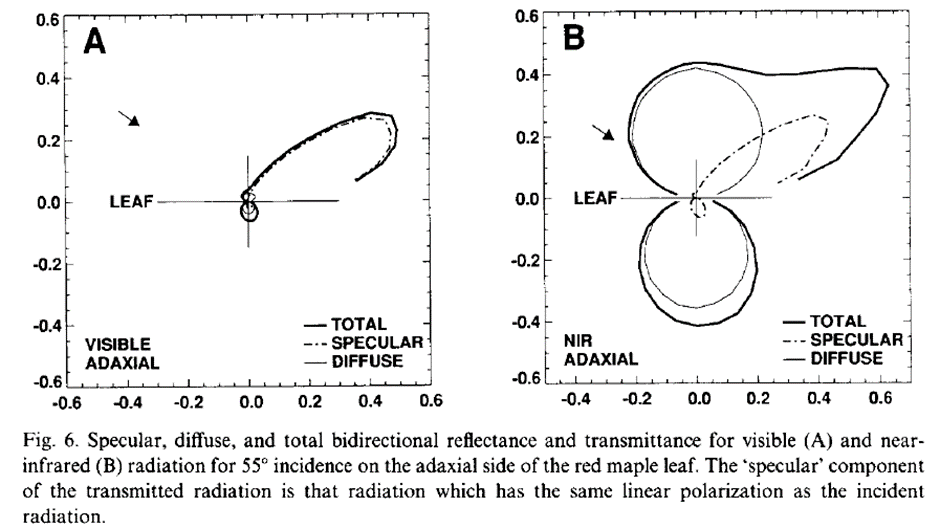Dear Radiance enthusiasts,
I’m seeking guidance on creating a trans material definition for modeling a leaf. While I’ve gathered a lot of information on this topic, my confidence remains somewhat low.
Here’s a summary of my approach:
1. Calculated Reflectance (R) and Transmittance (T) for a certain incident angle:
R = 26.35%
T = 26.5%
2. Determined proportion of diffuse and specular using BRTDFs:
- Reflectance:
Specular Rs = 25.1%
Diffuse Rd = 1.2%
- Transmittance:
Specular Ts = 1.6%
Diffuse Td = 24.9%
- Estimated Absorption (A):
A = 1 - (Rd + Rs) - (Td + Ts) = 47.2%
3. Calculated parameters A7 to A1:
A7 = Ts / (Td + Ts) = 0.06
A6 = (Td + Ts) / (Rd + Td + Ts) = 0.957
A5 = Sr = 0.1
A4 = Rs = 0.251
A3 = Cb / ((1 - Rs) * (1 - A6)) = 0.373
A2 = Cg / ((1 - Rs) * (1 - A6)) = 0.373
A1 = Cr / ((1 - Rs) * (1 - A6)) = 0.373
4. Material definition
void trans leaf
0
0
7 0.373 0.373 0.373 0.251 0.1 0.957 0.06
Assuming that the diffuse and specular components of reflectance and transmittance are calculated accurately, could you please confirm if this is the correct way to define the trans material in Radiance?
Your insights would be greatly appreciated!
Hi Funerus,
Welcome to our forum!
I guess you are treating the leaf color as gray, which may be fine. Most of your calculations look right and come out right, except I get a value for A1-A3 of 0.370, not 0.373. You may want to check that. The Cb, Cg, and Cr color values will all be equal to Rd in the gray case.
My main concern is your value for specular reflectance. Even with a high degree of roughness, a specularity above 0.08 is unrealistic for any surface not made of or coated by metal. How did you arrive at this value?
Cheers,
-Greg
Good morning Greg,
Thank you for taking the time to respond. Honestly, I feel like a teenager who just got an autograph from their favorite artist! 
The optical properties I used were based on what I like to call “grocery store math” – a rather rough approximation that seems less accurate the more I think about it.
The specular and diffuse components of reflectance and transmittance were estimated using the following BRTDFs for a 55-degree incidence angle:
(here is the link to the article https://www.sciencedirect.com/science/article/abs/pii/0168192394900167)
For each channel, visible and near-infrared, I estimated the area corresponding to the diffuse and specular components. Given the total reflectance and transmittance, one can then estimate the percentage of diffuse and specular components. Finally, I took the average of both channels to arrive closer to a broadband result.
Any further assistance would be greatly appreciated.
Kind regards,
Alex
Hi Alex,
Happy to help! It’s quite a challenge to get any semblance of the model parameters from a single, in-plane BSDF measurement from a particular angle. The area method, though clever, has a few issues:
-
Since it is an angular plot, the area near to the centroid is minimized, and won’t contribute as it should to an area integral.
-
There are additional cosine factors implicit to the integral, which also need to be figured.
In other words, I don’t think you can do it that way, at least not so easily. I’m also wondering how you plan to treat the Visible and NIR wavelengths in your model? Most of the difference in the distributions appears to be in the diffuse component, so you could probably get pretty close by calling the red channel NIR and manipulating the color.
Putting that aside for a moment, you might be able to start with a particular set of values for the “trans” type and reproduce plots like the one from the paper. Trial and error is the basic nature of science, after all… Start by plotting a known diffuse reflectance at different incident angles, until you get the normalization factors correct. Start with the rendering equation and use a differential area at a particular incident vector. (I would write it here, but I don’t know how to get the discourse editor to do math.)
Cheers,
-Greg
Dear Greg,
Thank you for your feedback once again.
For this preliminary analysis that I am conducting, I aim to model solar irradiance as a single broadband value (aggregated between 300-2800 nm). This is in accordance with the spectral response of broadband pyranometers and their GHI measurements (decomposed to DNI, DHI for use with gendaylit). Naturally, then, optical properties would need to be a single aggregated value in that wavelength range. As a result, at least for now, each RGB value will be the same.
Initially, I want to obtain a rough estimate of the irradiance distribution within my scene as soon as possible. For this reason, I’ll limit the broadband specular reflectance to 5%.
There’s definitely a lot to think about here. I’ll freshen up my math, and after some time I hope to post back here with any updates.
I am really happy to see an active Radiance community and hope to eventually contribute as well.
Wish you a pleasant week ahead,
Alex
